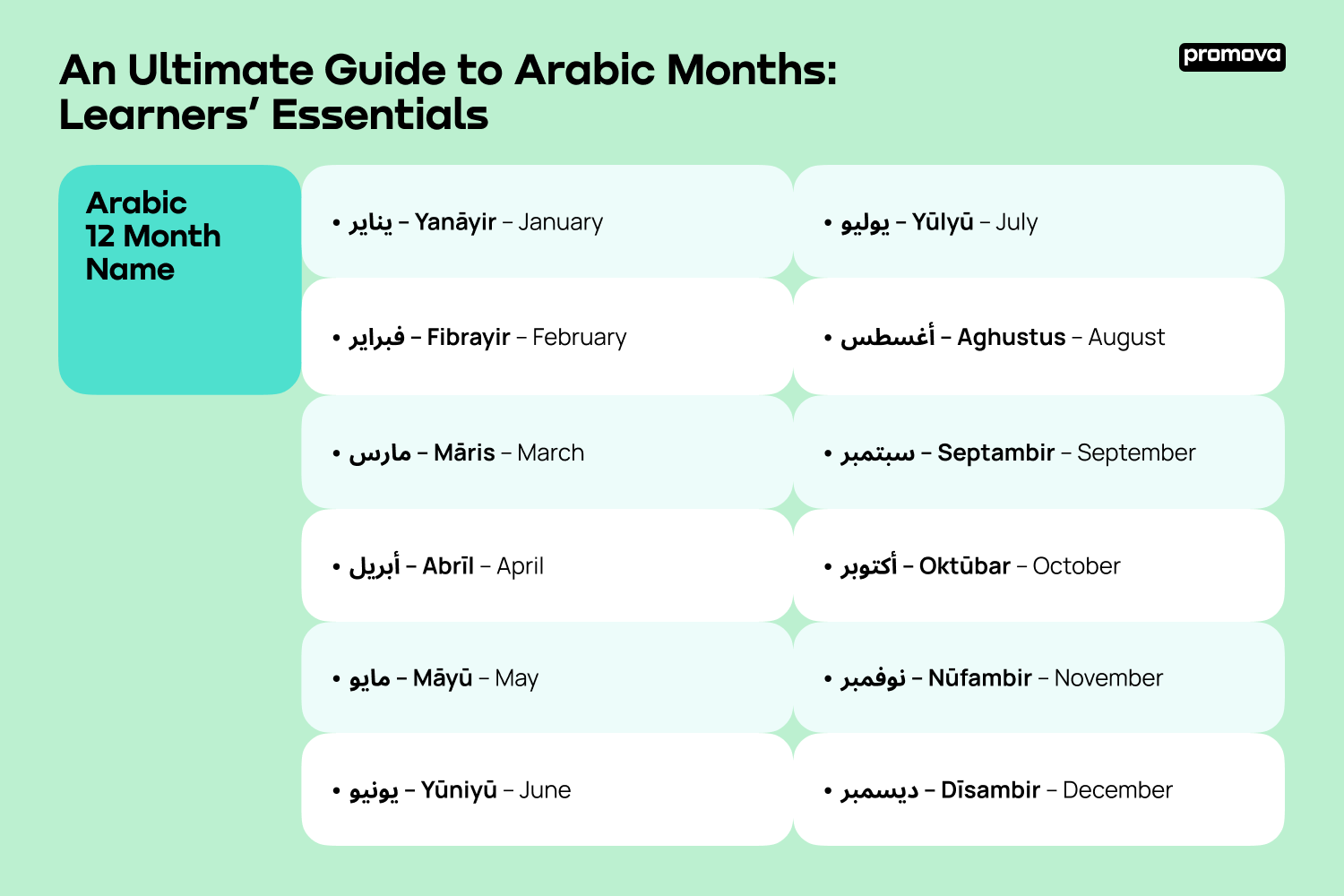An Ultimate Guide to Arabic Months: Learners’ Essentials

Contents
If you’re planning on learning Arabic, it is important to focus on the basics. And the names of Arabic months are one of those things you need to nail at the beginning of your journey. That’s why we are here today! So buckle up, and let’s jump right in.
Calendar Types in Arabic-Speaking Countries: Gregorian or Hijri?
Before explaining the names of the months, it is vital to understand the basics of calendars in Arabic-speaking countries. You might be surprised, but there are actually several types of calendars in Arabic, used in different regions and for various purposes. Below, we explain the two widely used options.
- Gregorian calendar. This is probably the most well-known calendar system, as it is used not only in Arabic countries but globally. It consists of 12 months, each with 30 or 31 days (except February, which has 28 or 29 in the leap year). Nowadays, this calendar is used in Arabic-speaking countries for most civil purposes, like government, business, education, and international affairs.
- Hijri calendar. This one has various names, including the Muslim calendar and the Islamic calendar. Just like the Gregorian, it consists of 12 months. However, there are a few significant differences. For example, the Gregorian calendar is based on a solar cycle, and Hijri – on the lunar one. Due to this difference, the Islamic year is around 11 days shorter. In the modern world, this calendar is used worldwide to determine the dates of religious events like Ramadan, Eid al-Fitr, and Eid al-Adha.
However, that’s not the complete list of calendars. In some countries, there are even more unique options, with their own purposes and even names of months of the year in Arabic. For example, in Egypt, alongside the previously mentioned systems, people use the ancient Coptic calendar, which consists of 13 months. Some natives in Algeria, Morocco, Tunisia, and Libya use the traditional Berber calendar to mark traditional festivals and cultural and agricultural events. And in Iraq, locals frequently refer to the Assyrian calendar for religious purposes.
Arabic 12 Month Name: Explained
As you can see, there are quite a few varieties of names. To avoid overwhelming you, we’ll focus on the two most used calendars. For starters, let’s begin with the Gregorian calendar.
- يناير – Yanāyir – January.
- فبراير – Fibrayir – February.
- مارس – Māris – March.
- أبريل – Abrīl – April.
- مايو – Māyū – May.
- يونيو – Yūniyū – June.
- يوليو – Yūlyū – July.
- أغسطس – Aghustus – August.
- سبتمبر – Septambir – September.
- أكتوبر – Oktūbar – October.
- نوفمبر – Nūfambir – November.
- ديسمبر – Dīsambir – December.

It’s difficult to deny that they are quite similar to the English names of these months, even in pronunciation. And now, here’s the list of Arabic calendar months according to the Hijri calendar and what they are known and significant for.
1. مُحَرَّم – Muharram.
During this month, people commemorate the day when Imam Hussain, the grandson of Prophet Muhammad, was martyred in the Battle of Karbala.
2. صَفَر – Safar.
Literally, the name of this month translates to “void.” Some people believe that it is called that because, in ancient times, Islamic Arab houses were empty during this time of the year while their occupants gathered food.
3. رَبِيع الأَوَّل – Rabi’ al-Awwal.
This one is another significant month for Muslims because, during it, Muhammad was born. Literally, this month in Arabic means “the first spring.”
4. رَبِيع الثَّانِي – Rabi’ al-Thani.
This is the fourth month in the Islamic lunar calendar. The name means “the second spring” or “the last spring” in Arabic. It is a time when the weather begins to warm up again, symbolizing a second phase of spring.
5. جُمَادى الأَوَّل – Jumada al-Awwal.
Although there aren’t any specific religious events happening during this month, some people believe that it was the time when the Prophet married Sayyida Khadija.
6. جُمَادى الثَّانِيَة – Jumada al-Thaniyah.
The literal meaning of this month’s name is “the last time of parched land.” It symbolizes the ending of that time when the land becomes dry and waterless. Also, it is the month when Fatima Zahra, the beloved daughter of the Prophet, was born.
7. رَجَب – Rajab.
The seventh month of the Islamic year has a significant name, which translates to “to respect.” During this time, Islamic people are not allowed to fight or commit any other sins. It is believed to be when the Prophet ascended to the heavens.
8. شَعْبَان – Sha’ban.
According to the Islamic calendar, this month’s name translates to “dispersion” or “separation” since ancient Arabs used to separate to find water during this time. It is an important period of preparation for Ramadan.
9. رَمَضَان – Ramadan.
This is one of the holiest months in the Arabic calendar. It is the time when Muslim people focus on worship, study of the Quran, and prayer. Also, during this period, they can’t eat during the day, so it is also considered the month of fasting. Many believe that Ramadan is the time when the Quran was revealed to Prophet Muhammad.
10. شَوَّال – Shawwal.
One of the most significant events during this month is Eid al-Fitr, which marks the end of Ramadan and the beginning of Shawwal. Eid al-Fitr is celebrated with special prayers, feasting, giving of gifts, and acts of charity.
11. ذُو الْقَعْدَة – Dhu al-Qi’dah.
Literally, the name of this month means “sitting” because, during this time, people are expected to stay sitting in place rather than go and fight each other.
12. ذُو الْحِجَّة – Dhu al-Hijjah.
The last month of the Islamic lunar year is also called the Month of the Pilgrimage. The Hajj pilgrimage occurs from the 8th to the 12th of Dhu al-Hijjah and involves a series of rituals performed in and around Mecca.
1
Learn Arabic Months in English with Promova
Like for any other language, learning dates, months, and other periods is essential for learners. When it comes to Arabic, it is not only the opportunity to expand the vocabulary but also to immerse yourself in a different culture. However, if your goal is to become fluent in the language, it is vital for you to focus on other aspects of the tongue, like speaking, reading, listening, and writing. And at Promova, we are glad to help you with them all!
Our convenient application is designed for fellow language enthusiasts with different learning styles. Here, you can practice essential skills and expand your vocabulary during engaging interactive lessons. Moreover, we focus on bite-sized learning, meaning that you can only spend a few minutes a day and still reach significant results. In addition to Arabic, you can learn Spanish, Korean, German, English, and many other languages.
The Promova application is available for both iOS and Android devices, so you can easily access your studying course anywhere and anytime you are comfortable. So what are you waiting for? Don’t hesitate, and give Promova a try!
Conclusion
Summing up, we can say that knowing the different names of Arabic months is an important practice. We hope that with the help of today’s lists, you’ll be able to memorize both Gregorian and Hijri calendars and months. And that’s it for now! We’ll see you in the next article.
FAQ
Why should I learn the names of Arabic months?
In addition to language-learning benefits, such as vocabulary expansion and pronunciation practice, this knowledge provides you with exposure to a foreign culture and religion, allowing you to get acquainted with new customs and traditions.
What are the four holy months in the Hijri calendar?
These are Muharram (the first month of the Islamic calendar), Rajab (the seventh month), Dhu al-Qi’dah (the eleventh month), and Dhu al-Hijjah (the twelfth month).
Are there any regional variations in the names of the months in Arabic?
Yes, absolutely, there are plenty of variations. For example, in Iraq and the Levant, the names of Gregorian months, which mainly come from the Babylonian and Hebrew calendars, differ from those in Algeria and Tunisia, which are based on French names of the months. That’s why the same time periods are called differently (e.g., January is Kānūn aṯ-Ṯānī in Iraq and Jānvi in Algeria, February is Šubāṭ and Fīvri, etc.).
Are there any modern adaptations or changes to the traditional Arabic calendar?
Actually, no, there weren’t any significant changes. Although nowadays, the Gregorian calendar is used for most civil purposes, the Hijri calendar holds a significant place in terms of religion, marking the most sacred days and months for Muslim people.



Comments